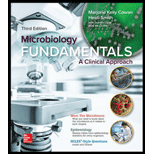
Concept explainers
Introduction:
Infections occur due to an abnormal condition of body that disrupts important physical and physiological function of body. Disease is caused by improper diet, lack of exercise, various infectious agents that are present in nature, toxic substances, genetic disorders, and depression, stress that play role in illness and disturbs normal functioning of body.
Answer to Problem 1Q
Correct answer:
Clostridium difficile is a most common cause of acute diarrhea and is associated with CDC due to its antibiotic resistance characteristics. Therefore, option (b) is correct.
Option (b) is given as “Clostridium difficile”.
Explanation of Solution
Justify reason for the correct statement:
There are some drug resistant pathogens are present in large intestine such as C.difficile. An antibiotic treatment may disrupt large intestine as antibiotic disturbs normal biota. Due to these bacteria produces two enterotoxins such as toxin A and B causes necrosis in intestinal walls and results in diarrhea as well as Clostridium difficile colitis. It is condition occurs in which inflammation occurs in colon.
Hence, option (b) is correct.
Justify reasons for the incorrect statements:
Option (a) is given as “Salmonella”.
It is found in the intestine of humans and animals. It causes infections through contaminated food and water. It is does not CDC. Hence, it is a wrong answer.
Option (c) is given as “Cryptosporidium”.
It is microscopic
Option (d) is given as “Shigella”.
It is bacteria which causes acute diarrhea in humans by ingestion of contaminated food and water. Hence, it is a wrong answer.
Hence, options (a), (c) and (d) are incorrect.
The bacteria Clostridium difficile is resistant to antibiotics and may cause Clostridium difficile colitis in which inflammation occurs in colon.
Want to see more full solutions like this?
Chapter 20 Solutions
Microbiology Fundamentals: A Clinical Approach
- Blood in the stool may occur in which of the following? a. Salmonella infection b. rotavirus infection c. Clostridium difficile infection d. Shigella infection e. b, c, and d f. a, c, and darrow_forwardDiarrhoea is not caused by: A)Shigella dysenteriae B)Streptococcus pyogenes C)Clostridium difficile D)Salmonella enteriditisarrow_forward78. A food-borne outbreak of gastroenteritis is being investigated. Which of the following concerns is the priorityfor a microbiologist?A. Gastroenteritis may be caused by several bacterial and viral pathogens.B. General food safety measures may have been violated during preparation.C. Several food sources may have been shared by the affected individuals.D. Symptoms of gastroenteritis may include diarrhea, nausea, and vomiting.79. An outbreak of dengue fever is to be investigated. Which of the following descriptive epidemiologyconsiderations is the most appropriate and urgent starting point for the investigation?A. AGENT – detection of Plasmodium(+) mosquitoesB. PERSON – age and sex distribution of casesC. PLACE – clustering of cases within a certain areaD. TIME – analysis of cases over a ten-year periodarrow_forward
- Thiamin deficiency leads to a.Pellagra b.Beriberi c.Cheilosis d.Macrocytic anemiaarrow_forwardSome patients who take antibiotics for acne develop yeast infections of the mouth or genitourinary tract. Explainarrow_forwardWhich of the following is the cause of mycotoxicosis?a. Mucor b. Pneumocystisc. Aspergillus d. Cryptococcusarrow_forward
- Antimicrobial therapy can decrease the amount of susceptible bowel flora and allow proliferation of relatively resistant colonic bacteria. Which one of the following species can proliferate and produce a toxin that causes diarrhea?- a.Enterococcus species b.Staphylococcus epidermidisC.Pseudomonas aeruginosad.Clostridium difficilee.Bacteroides fragilisarrow_forwardThe most common bacterial cause of diarrhea in the United States is________________arrow_forwardA local hospital reports an increase in admissions of toddlers for dehydration secondary to acute gastroenteritis over the past three days to the county health department. As the officer assigned to investigate, what information from the hospital do you want to obtain that will help you identify the cause of the outbreak and institute preventive measures if indicated?arrow_forward
- When reviewing the allergy history of a patient, the nurse notes that the patient is allergic to penicillin. Based on this finding, the nurse would question an order for which class of antibiotics? a. Tetracyclines b. Cephalosporins c. Sulfonamides d. Quinolonesarrow_forwardWhich of these diseases is spread by needle sticks Question options: A) Hepatitis C B) Rocky Mountain spotted fever C) Syphilis D) All of the abovearrow_forwardAn antibiotic that disrupts the normal flora can causea. the teeth to turn brown b. aplastic anemia c. a superinfection d. hepatotoxicityarrow_forward
- Essentials of Pharmacology for Health ProfessionsNursingISBN:9781305441620Author:WOODROWPublisher:Cengage
 Comprehensive Medical Assisting: Administrative a...NursingISBN:9781305964792Author:Wilburta Q. Lindh, Carol D. Tamparo, Barbara M. Dahl, Julie Morris, Cindy CorreaPublisher:Cengage Learning
Comprehensive Medical Assisting: Administrative a...NursingISBN:9781305964792Author:Wilburta Q. Lindh, Carol D. Tamparo, Barbara M. Dahl, Julie Morris, Cindy CorreaPublisher:Cengage Learning  Medical Terminology for Health Professions, Spira...Health & NutritionISBN:9781305634350Author:Ann Ehrlich, Carol L. Schroeder, Laura Ehrlich, Katrina A. SchroederPublisher:Cengage Learning
Medical Terminology for Health Professions, Spira...Health & NutritionISBN:9781305634350Author:Ann Ehrlich, Carol L. Schroeder, Laura Ehrlich, Katrina A. SchroederPublisher:Cengage Learning



